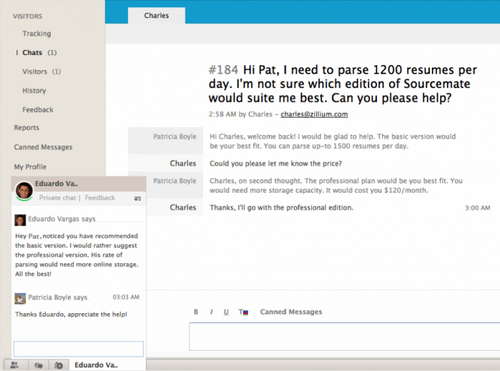nine Effective Tips for Customer Service on Social Media
The advent of social media has had a gigantic influence on the customer service industry. Not only can people go directly to companies and get quick feedback on their questions and problems, but they can also call out businesses in a public forum, making it all the more significant for their questions to be answered quickly and efficiently.
Here are nine tips on how to suggest the most effective customer service on social media. These tips will keep you from wasting time and ensure that your customers are getting their questions answered in a timely manner.
[Free Training] Live Talk & Customer Service Certification
This free training features up-to-date customer service best practices, to help you boost your abilities and become a true customer service professional.
Train Support Teams and Delegate Social Channels
The downfall of many businesses on social media is that no one knows who’s in charge of answering customer queries. Is it the marketing department or the call center’s responsibility? That’s a problem, because it means in all likelihood questions are being overlooked or going unanswered. If you don’t think it’s your job to react to someone on Facebook, you won’t do it, and then that question is stringing up around for days without getting a response.
Be Consistent
Another benefit of having one person oversee all social media customer service is making your brand’s responses more consistent. You don’t want a customer on Twitter to notice that a customer who complained about the same issue on Facebook got a utter refund, while the Twitter customer got a mere fifty percent back.
Response Quickly
Years ago, it might take days or even weeks for customer service to reaction a question from a customer. These days if you wait more than an hour after someone asks a question on social media, they get twitchy. Studies have shown that people expect very quick turnarounds on questions they ask via Twitter.
Have a Personality
Even if they are voicing a complaint, they want to know that a real person has heard their concern and can suggest an reaction. That’s something they can’t get from an automated phone service, which was the old way of answering many customer complaints.
Own Up to the Problem
It can be tempting to attempt to protect your brand on social media, by pushing away customer complaints or attempting to shield your company from criticism. But if you engage in this sort of behavior, you’re also by default dismissing your customers’ complaints without doing anything to fix their problem. Rather than being defensive or going on the offensive, you need to acknowledge that your customer has a problem.
Be Proactive
Sometimes customers reach out not to complain or praise but with a concern. In this case, you want to make sure your customer service team knows to address things brought up by the customer even if it’s not a pressing issue or even something that necessarily has to do with your company. Anytime you can provide assistance to the customer, however it’s not technically your area of expertise or service, go that extra mile. You’ll be rewarded with their loyalty.
The GiftWorks team responds in a timely manner to a user who missed out on a free webinar they suggested. Even however they’re not making money by suggesting the webinar, they’re demonstrating brand values by still responding to their question and building anticipation for their future webinars.
Have Ears Where You Have Profiles
Customers also expect their support practice on social channels to ascend that of traditional call support. That means friendlier and private; timely and convenient. Implements such as Hootsuite permit us to manage numerous social profiles at once, which is ideal for customer support representatives.
Another way to streamline social media support is to have someone who monitors channels and refers complaints/questions to a live talk representative on your site. This is a fine way to instantaneously connect a customer – or potential customer – in a convenient and professional manner.
Tell Before People Ask
Snafus happen. Sooner or later your company will run into a problem. It could be as puny as a web site glitch or it could be as big as a major recall impacting everyone who’s bought something from your store in the past year. When a crisis like this hits, it’s significant to solve the problem, of course, but it’s also significant to keep your customers abreast of the developments as you work to find solutions.
Use the Right Person to Reply
Comcast has a Twitter account dedicated to addressing technical problems on its networks. The cable and Internet service provider gets lots of tweets about service, and so it makes sense to have someone technically savvy available to response those questions. When a customer tweets a complaint, the customer care representative can contact that person and find out more about the issue. Sometimes all it takes is a quick reboot or following up with a few more queries to get the problem solved. If it’s a thicker issue, it can then be passed off to an on-site customer support representative, but at least Comcast attempted for a quick social media resolution.
[White Paper] The Guide to Becoming a Top Performing Live Talk Operator
Well-trained operators mean better customer satisfaction. Here we suggest twelve essential tips for live talk operators to communicating effectively, addressing customer issues efficiently, and indicating your brand professionally.
About Jesse Aaron
Jesse Aaron is a professional marketing blogger and a Community Manager at WebpageFX. He writes about eCommerce, social media marketing, and conversion rate optimization. Go after Jesse on Google+
Get Fresh Content in Your Inbox
Receive the latest customer service and ecommerce tips.
